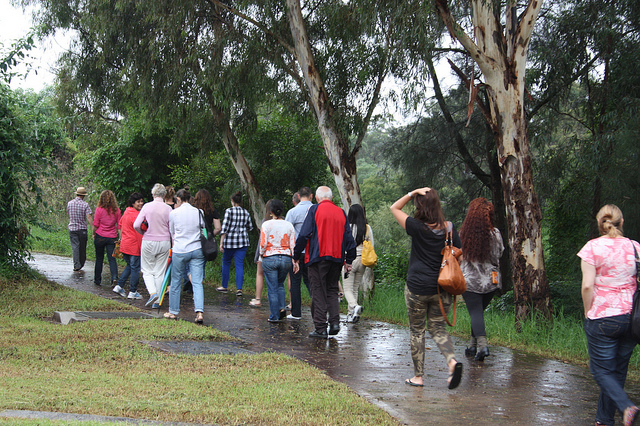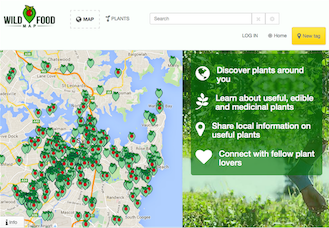
Diego Bonetto is an artist, naturalist and environmental educator known for his urban foraging workshops that aim to rediscover lost knowledge, celebrate cultures through plants and share foraging information.
Before meeting Diego Bonetto I divided the entire plant world into useful plants and weeds.
Now as I walk my dog or travel on the train my attention is no longer only drawn to what is flowering in peoples gardens but also to the broad array of weed species. I can now identify a number of them, remember several of their traditional uses and feel curious to know more.

Image: Diego Bonetto (Flickr)
On the sold out workshop I attended in Tempe he had us utterly captivated. He explained that he views himself as a “vessel” for the knowledge he was sharing and encouraged workshop participants to share their knowledge and stories as well. During our walk we located plants such as dandelions, flatweed, chickweed, flickweed, as well as indigenous species including warrigal greens, lomandra and pigface.
According to Diego “three generations ago this would have been common knowledge” within communities. He views weeds as a largely untapped resource beneath our feet. He learnt the skills himself growing up in Italy, collecting with his sister for family meals.

Image: Adam Porter (Flickr)
The workshops originated from an art exhibition and public program he did at Casula Powerhouse Arts Centre called “Wild Stories” where he collected stories about plants from all over the world and explored community and cultural connections with the Australian environment. Diego felt there was a need for a new understanding of environmental care, respect and stewardship. The exhibition also featured terrariums of plants and jars of homemade pickles.
For me, this experience has challenged my black and white thinking, built a deeper affinity for nature and introduced me to the vast array of plants that we can make use of.
Through sharing his knowledge about the culinary, medicinal and the cultural value of weeds, Diego encourages us to build a new respect for these plants and for nature itself. He believes that engaging and reconnecting with nature is an important component of solving environmental problems.
“I’VE BEEN PROMOTING WEEDS AS A POSSIBLE FOOD SOURCE FOR MANY YEARS… FORAGING IS JUST ANOTHER WAY TO PUT FORWARD APPRECIATION TOWARDS WHATEVER NATURE IS GIVING US. I WOULD LIKE TO SEE PEOPLE ENGAGE WITH LAND WITH RESPONSIBLE ACTIONS AND WITH CLEAR GOALS OF CREATING ABUNDANCE.”
– DIEGO BONETTO

Flickweed Image: Anna Gregory
Diego is careful to point out the important rules of foraging to keep everyone safe as well as to teach respect for the environment. These rules also apply to indigenous flora.
Three rules for foraging:
- Only forage where you know about the soil and whether plants have been sprayed with pesticides. Your own garden is the best place to forage.
- Positively identify everything without exception! There are plenty of references to look up as well as weed lovers (just like Diego) who are more than happy to assist you.
- Be nice to the colony; don’t over-harvest. Eat small and say thank you.
In urban environments it’s particularly important to be aware of the possibility of metals and metalloids in the soil that may have built up over time as a result of pollution from manufacturing, traffic, waste dumps and building renovations. Lead is one concern and this can even be a problem in your own backyard.
To Diego, weeds are also symbolic of the way in which humans try and control nature rather than to co-exist with it.
“WEEDS IS AN ARBITRARY TERM WE PUT ON ANYTHING GREEN WE DON’T LIKE BUT MANY OF THESE WEEDS MAKE DELICIOUS SALADS AND SEASONAL TREATS AND ARE A WASTED RESOURCE LITERALLY UNDER YOUR FEET.”
– DIEGO BONETTO

Image: Wildfood Map
In a recent project Diego has worked with horticulturalists, naturalists and web producers to develop the Wild Food Map Project, an online interactive map of foraging locations for wild plant species linked to information about how plants can be used both medicinally and for food. He explains “the aim is to create a mapping system that people can use to locate and identify foods and medicine sources in their neighbourhood”. The project is community-driven and people are able to login and post locations and comments.
So will I stop pulling out weeds causing great harm in the environment?
No I won’t, but where possible I’ll look into harvesting them instead of simply destroying them.
When I do remove weeds I’ll do it with more respect for the plants origins and cultural significance. To me they might be plants growing in the wrong place, but these plants aren’t inherently bad. They all have their own stories.

Rambling dock image: Anna Gregory
Flickweed and rambling dock were my two favourite weed tastings with Diego and I’ve found both of these on my parents’ property where I know the soil is healthy and no pesticides have been sprayed. I have even transplanted some flickweed into a pot at home and so far it’s doing well.
WEEDS ARE THE ULTIMATE CONVENIENCE FOOD. THEY ASK OF YOU NO MONEY, NO SEARCH FOR A PARKING SPOT AT THE SUPERMARKET, NO PLANTING, NO WATERING, OR ANY OTHER MAINTENANCE WHATSOEVER.
– THE WEED FORAGERS HANDBOOK
In a world where we are bombarded with facts and figures about climate change and other environmental issues, artists have a unique role in helping us bridge our understanding and motivating change in our behaviour through connecting and engaging with nature. Diego Bonetto is a great example of such an artist.
When the weather warms up I’m keen to journey out to meet Diego for another urbanforaging workshop so that he can point out more seasonal weedy treats and so I can soak up more of his infectious passion for the natural world.
Banner image: Anna Gregory
